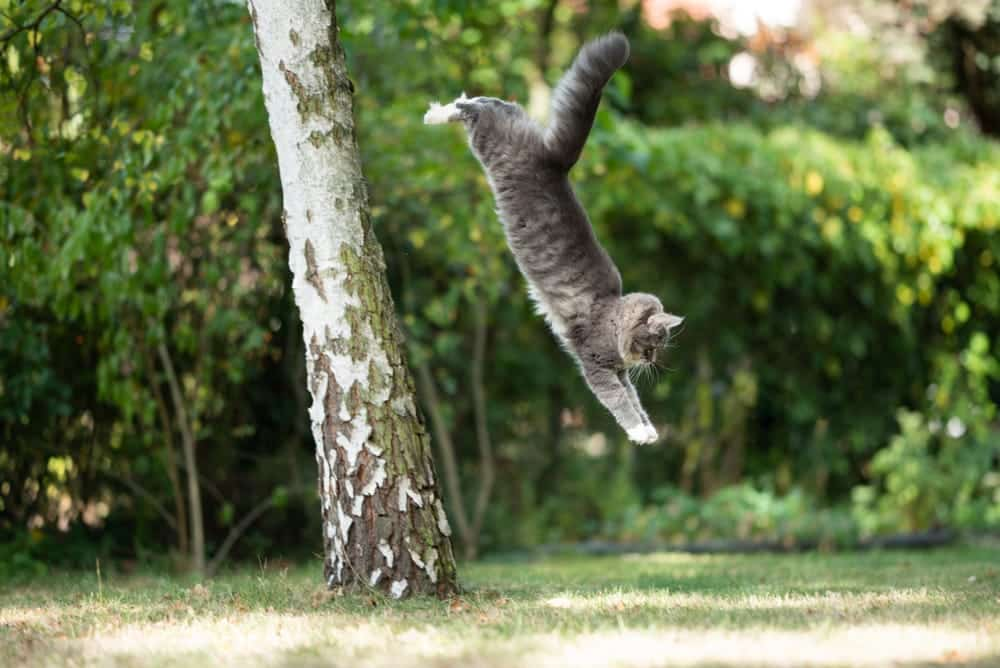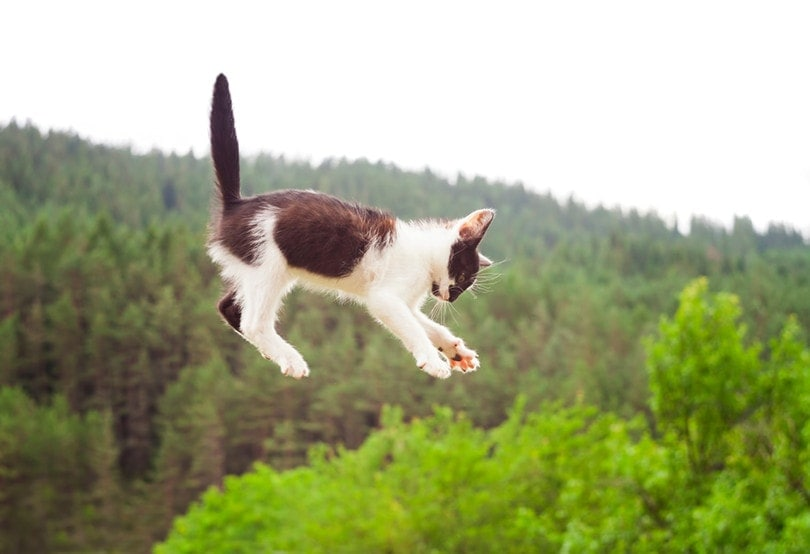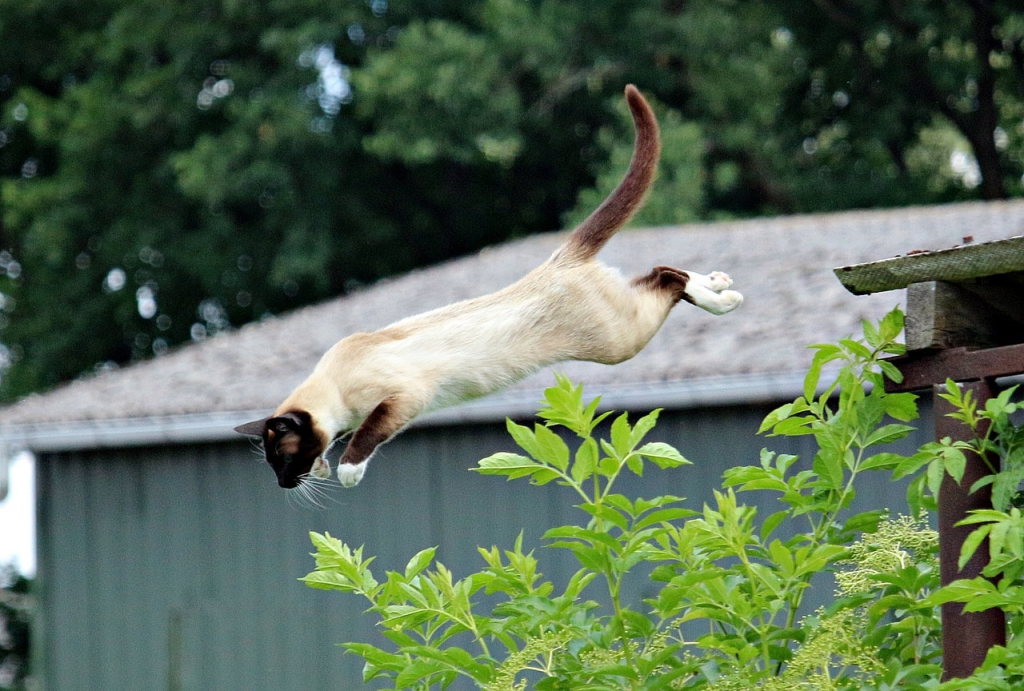You’ve probably heard the saying: Cats always land on their feet. It’s a catchy phrase—and mostly true. But the real jaw-dropper? Cats don’t just land on their feet—they often walk away unharmed from falls that would leave humans in serious trouble. We’re talking seven stories. Ten. Even up to 32.
Sounds impossible, right? But it’s not magic—it’s biology, physics, and evolution working together like a perfectly synchronized stunt team. So let’s break it down and figure out why your average housecat is better at surviving high-altitude disasters than you are.

The 3-Foot Rule: Where Cat Physics Begins
If your cat jumps out of your arms or off the fridge, chances are she’s fine. Why? Because anything over three feet gives her just enough time to activate what scientists call the righting reflex. This reflex kicks in within milliseconds, allowing her to twist mid-air and position her feet under her body.
How does she pull it off?
- Vestibular system: Her inner ears work like a super-precise gyroscope, helping her know which way is up.
- No collarbone: Without this bone, cats have a unique range of motion in their shoulders.
- Hyper-flexible spine: Her body can bend and twist in ways that would make a yogi jealous.
Put it all together, and she can rotate her front half, then the back half, and land on all fours—graceful as ever.
Video: How This Cat Survived A 32-Story Fall
But What If She Falls From Lower Than Three Feet?
Less time in the air doesn’t mean disaster. Even in a short fall, cats have those sharp claws and instinctive skills. If your cat’s slipping off a chair or low perch, she’ll often grab a nearby surface, push off a wall, or use her hind legs to adjust mid-tumble.
So unless your living room is made of lava or glass shards, she’s probably okay.
Leaps, Not Falls: The Second-Story Myth
A lot of worried cat parents stress about their feline friends jumping from windows or balconies. But here’s the thing: most of these are leaps, not accidents. Cats usually plan these jumps—and when they do, they’re already aligned for a safe landing.
Even if the jump is unexpected, anything above that 3-foot threshold usually gives them enough time to twist and prep. As long as the ground is clear, flat, and not made of concrete spikes, second-story drama is usually survivable.
The Danger Zone: Mid-Rise Mayhem

Now it gets interesting. Falls from 5 to 9 stories? That’s the sweet spot of risk. It’s long enough to build serious speed but not long enough for their bodies to fully relax and maximize survival techniques.
This range is where cats get hurt the most. They may still land on their feet, but they’re hitting the ground fast—and hard. Think bruises, broken bones, and vet visits. But go higher? Something bizarre happens…
Above Nine Stories? Cats Do Better. Seriously.
Once a cat falls from higher than 9 stories, they tend to have fewer injuries. Wait—what?
Enter terminal velocity—the point where an object stops accelerating and falls at a constant speed. For humans, that’s about 120 mph. For cats? Closer to 60 mph. That’s a big difference.
By 7–9 stories, most cats hit terminal velocity. But instead of panicking, they do the wildest thing imaginable…
They Relax.
Video: How do Cats Survive High Falls?
Yup. While your brain would scream brace for impact, cats do the opposite. Once their speed levels off, their bodies go limp—like a ragdoll in the wind. This reduces the shock of impact and allows their limbs to absorb the landing better.
Relaxed muscles = fewer injuries. Sounds absurd, but it’s evolutionary genius.
The Flying Squirrel Pose: Slowing Down Mid-Fall
But cats don’t stop there. Once they’ve hit terminal velocity and relaxed, many of them spread their limbs wide—like a feline parachute. This increases air resistance and may actually slow them down even more.
It’s like they’ve instinctively learned to glide, just enough to soften the final few feet of their descent.
Researchers aren’t 100% sure how much this gliding technique slows them down—it’s hard to ethically study free-falling cats, after all—but the survival rates from higher falls are too consistent to ignore.
But Let’s Be Clear—Cats Aren’t Invincible
Before you start testing this theory from your balcony: don’t. Yes, cats are built for agility and survival. But they’re still vulnerable to:
- Hard surfaces like pavement
- Jagged objects or glass
- Internal injuries
- Disorientation after the fall
And let’s not forget the emotional trauma. A fall that doesn’t break bones can still shake them to the core.
Protect Your Cat From the Urban Jungle

No matter how impressive their survival skills are, we shouldn’t take chances. If you live in an apartment or high-rise:
- Keep windows closed or securely screened
- Avoid leaving cats unsupervised on balconies
- Watch out for ledges and unstable surfaces
The goal isn’t to bubble-wrap your cat—it’s to keep her from becoming a daredevil by accident.
Conclusion: The Marvel of the Midair Meow
So how do cats survive crazy high falls? It’s a mix of incredible instincts, flexible bones, physics, and pure feline finesse. From the righting reflex to terminal velocity relaxation, they’ve evolved into some of nature’s most graceful survivors.
But as cool as it is to learn why cats can survive falls from skyscrapers, let’s make sure we never have to find out firsthand.
Because while cats have nine lives… we should make sure they only need one.


